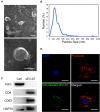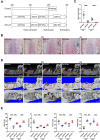Small Extracellular Vesicles Derived from Adipose Tissue Prevent Bisphosphonate-Related Osteonecrosis of the Jaw by Promoting Angiogenesis
- PMID: 33994785
- PMCID: PMC8114828
- DOI: 10.2147/IJN.S305361
Small Extracellular Vesicles Derived from Adipose Tissue Prevent Bisphosphonate-Related Osteonecrosis of the Jaw by Promoting Angiogenesis
Abstract
Purpose: There is no definitive treatment for bisphosphonate-related osteonecrosis of the jaw (BRONJ). Small extracellular vesicles derived from adipose tissue (sEV-AT) have been proved efficient at promoting tissue regeneration. The aim of this study was to evaluate the effects of sEV-AT administration on BRONJ-like lesions in rats.
Methods: Zoledronate (Zol) and dexamethasone (Dex) were subcutaneously administered to create a BRONJ rat model. Rats were randomly divided into three groups: 1) Control; 2) Zol+Dex; 3) sEV-AT. The maxillary left first molars were extracted two weeks after the first administration. In the sEV-AT group, sEV-AT were given intravenously every three days right after tooth extraction. We preformed occlusal view images, microcomputed tomography (µCT) and histological analysis to measure the regeneration of osseous and soft tissue in extraction sockets. Human umbilical vein endothelial cells (HUVECs) were isolated and cultured with endothelial cell medium (ECM). HUVECs were then divided into three groups: 1) Control: ECM; 2) Zol: ECM+Zol; 3) sEV-AT: ECM+Zol+sEV-AT. We evaluated the proliferation, tube formation and migration of HUVECs in each group.
Results: Rats treated with Zol+Dex showed BRONJ-like lesions including open wounds, necrotic bones, empty osteocyte lacunae and reduced osteoclasts. sEV-AT administration reduced BRONJ-like lesions by promoting soft tissue healing. µCT results showed that bone volume in extraction sockets in the sEV-AT group was larger than the Zol+Dex group. Histological analysis showed less necrotic bones and empty osteocyte lacunae in the sEV-AT group compared to the Zol+Dex group. Histological analysis also showed more osteoclasts, collagen fibers and blood vessels in the sEV-AT group compared to the Zol+Dex group. Furthermore, sEV-AT enhanced the proliferation, migration and tube formation of HUVECs which were inhibited by Zol.
Conclusion: Our findings indicate that sEV-AT prevent BRONJ in rats. Angiogenesis promotion contributes to the prevention of BRONJ.
Keywords: adipose tissue; angiogenesis; bisphosphonate-related osteonecrosis of the jaw; endothelial cells; small extracellular vesicles.
© 2021 Huang et al.
Conflict of interest statement
The authors report no conflicts of interest in this work.
Figures





Similar articles
-
Establishment of an Animal Model of Bisphosphonate-Related Osteonecrosis of the Jaws in Spontaneously Diabetic Torii Rats.PLoS One. 2015 Dec 14;10(12):e0144355. doi: 10.1371/journal.pone.0144355. eCollection 2015. PLoS One. 2015. PMID: 26659123 Free PMC article.
-
Transplantation of Noncultured Stromal Vascular Fraction Cells of Adipose Tissue Ameliorates Osteonecrosis of the Jaw-Like Lesions in Mice.J Bone Miner Res. 2018 Jan;33(1):154-166. doi: 10.1002/jbmr.3292. Epub 2017 Oct 4. J Bone Miner Res. 2018. PMID: 28902422
-
Zoledronic Acid Deteriorates Soft and Hard Tissue Healing of Murine Tooth Extraction Sockets in a Dose-Dependent Manner.Calcif Tissue Int. 2022 Jan;110(1):104-116. doi: 10.1007/s00223-021-00890-9. Epub 2021 Aug 7. Calcif Tissue Int. 2022. PMID: 34363509
-
Systemic administration of quality- and quantity-controlled PBMNCs reduces bisphosphonate-related osteonecrosis of jaw-like lesions in mice.Stem Cell Res Ther. 2019 Jul 16;10(1):209. doi: 10.1186/s13287-019-1308-8. Stem Cell Res Ther. 2019. PMID: 31311585 Free PMC article.
-
[Basic Studies on the Mechanism, Prevention, and Treatment of Osteonecrosis of the Jaw Induced by Bisphosphonates].Yakugaku Zasshi. 2020;140(1):63-79. doi: 10.1248/yakushi.19-00125. Yakugaku Zasshi. 2020. PMID: 31902887 Review. Japanese.
Cited by
-
Recent advances in the use of extracellular vesicles from adipose-derived stem cells for regenerative medical therapeutics.J Nanobiotechnology. 2024 Jun 6;22(1):316. doi: 10.1186/s12951-024-02603-4. J Nanobiotechnology. 2024. PMID: 38844939 Free PMC article. Review.
-
Preservation of Small Extracellular Vesicle in Gelatin Methacryloyl Hydrogel Through Reduced Particles Aggregation for Therapeutic Applications.Int J Nanomedicine. 2021 Nov 30;16:7831-7846. doi: 10.2147/IJN.S334194. eCollection 2021. Int J Nanomedicine. 2021. PMID: 34876812 Free PMC article.
-
Establishment and assessment of rodent models of medication-related osteonecrosis of the jaw (MRONJ).Int J Oral Sci. 2022 Aug 10;14(1):41. doi: 10.1038/s41368-022-00182-4. Int J Oral Sci. 2022. PMID: 35948539 Free PMC article. Review.
-
Recent Stem-Cell-Based and Stem-Cell-Free Possibilities for the Therapeutic Management of the Osteonecrosis of the Jaw.Biomolecules. 2025 Apr 16;15(4):595. doi: 10.3390/biom15040595. Biomolecules. 2025. PMID: 40305370 Free PMC article. Review.
-
Comparison of two cell-free therapeutics derived from adipose tissue: small extracellular vesicles versus conditioned medium.Stem Cell Res Ther. 2022 Mar 3;13(1):86. doi: 10.1186/s13287-022-02757-8. Stem Cell Res Ther. 2022. PMID: 35241142 Free PMC article.
References
-
- Ramaglia L, Guida A, Iorio-Siciliano V, Cuozzo A, Blasi A, Sculean A. Stage-specific therapeutic strategies of medication-related osteonecrosis of the jaws: a systematic review and meta-analysis of the drug suspension protocol. Clin Oral Investig. 2018;22(2):597–615. doi:10.1007/s00784-017-2325-6 - DOI - PubMed
MeSH terms
LinkOut - more resources
Full Text Sources
Other Literature Sources

